brake light MERCEDES-BENZ SLS AMG GT COUPE 2015 C197 Owner's Guide
[x] Cancel search | Manufacturer: MERCEDES-BENZ, Model Year: 2015, Model line: SLS AMG GT COUPE, Model: MERCEDES-BENZ SLS AMG GT COUPE 2015 C197Pages: 290, PDF Size: 6.24 MB
Page 176 of 290
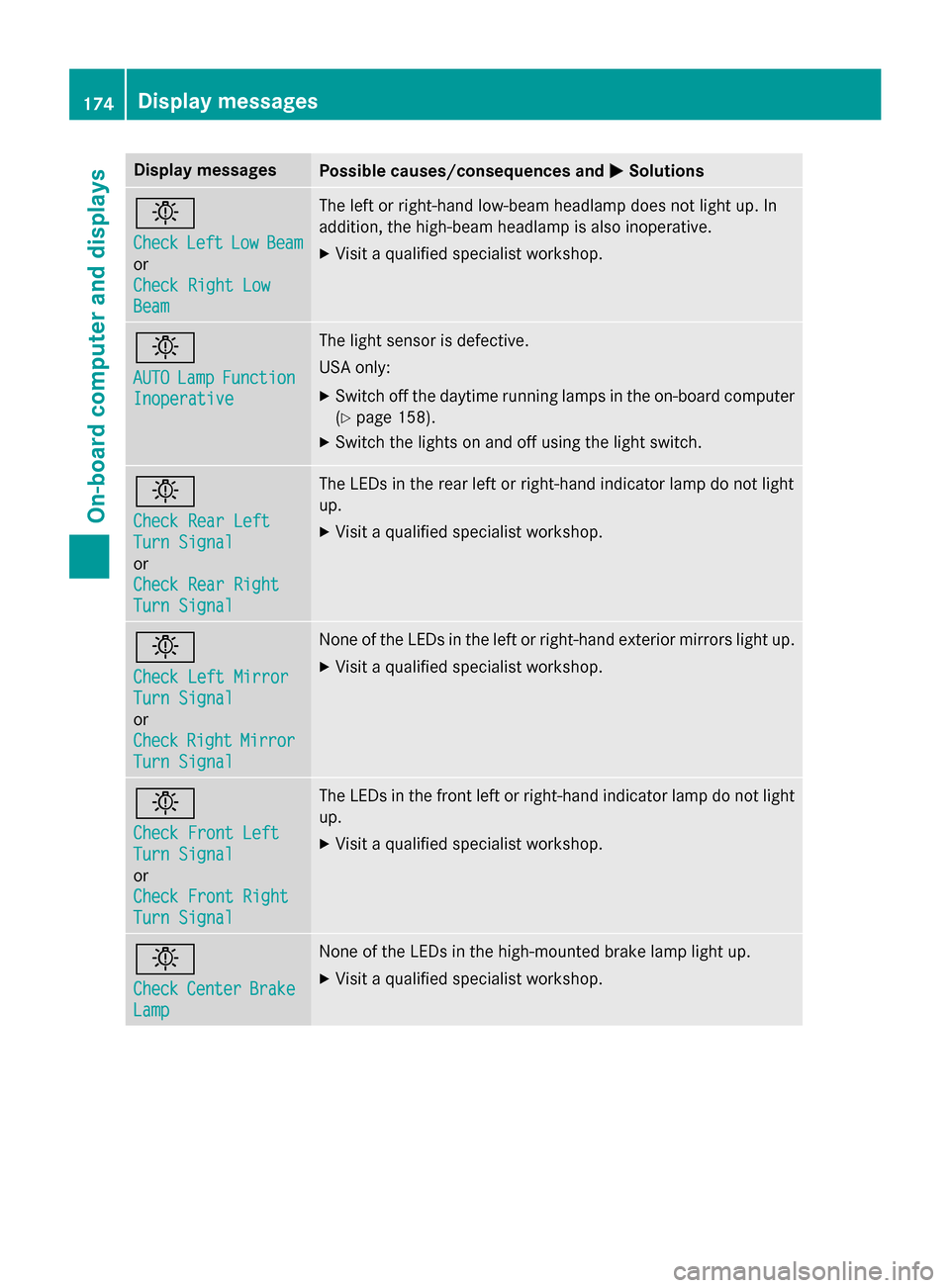
Display messages
Possible causes/consequences and
0050
0050Solutions 0049
Check Check
Left
LeftLow
LowBeam
Beam
or
Check Right Low Check Right Low
Beam Beam The lef
torright-hand low-beam headlamp does no tligh tup. In
addition ,the high-beam headlamp is also inoperative.
X Visit aqualified specialist workshop. 0049
AUTO AUTO
Lamp
LampFunction
Function
Inoperative
Inoperative The ligh
tsensor is defective.
US Ao nly:
X Switc hoffth ed aytime running lamp sintheon-boar dcom puter
(Y page 158).
X Switc hthe lights on and of fusin gthe ligh tswitch. 0049
Check Rea
rLeft
Check Rea rLeft
Tur nS ignal
Tur nS ignal
or
Check Rea rRight
Check Rea rRight
Tur nS ignal
Tur nS ignal The LEDs in th
erear lef torright-hand indicato rlamp do no tlight
up.
X Visit aqualified specialist workshop. 0049
Check Lef
tMirror
Check Lef tMirror
Tur nS ignal
Tur nS ignal
or
Check Check Right
RightMirror
Mirror
Tur nS ignal
Tur nS ignal Non
eoft heLEDs in th eleftorr ight-hand exterio rmirror sligh tup.
X Visit aqualified specialist workshop. 0049
Check Front Left Check Front Left
Tur
nS ignal
Tur nS ignal
or
Check Front Right Check Front Right
Tur nS ignal
Tur nS ignal The LEDs in th
efront leftorr ight-hand indicato rlamp do no tlight
up.
X Visit aqualified specialist workshop. 0049
Check Check
Center
Center Brake
Brake
Lamp
Lamp Non
eoft heLEDs in th ehigh-mounte dbrak elamp ligh tup.
X Visit aqualified specialist workshop. 174
Display
messagesOn-boardcomputer an ddisplays
Page 177 of 290
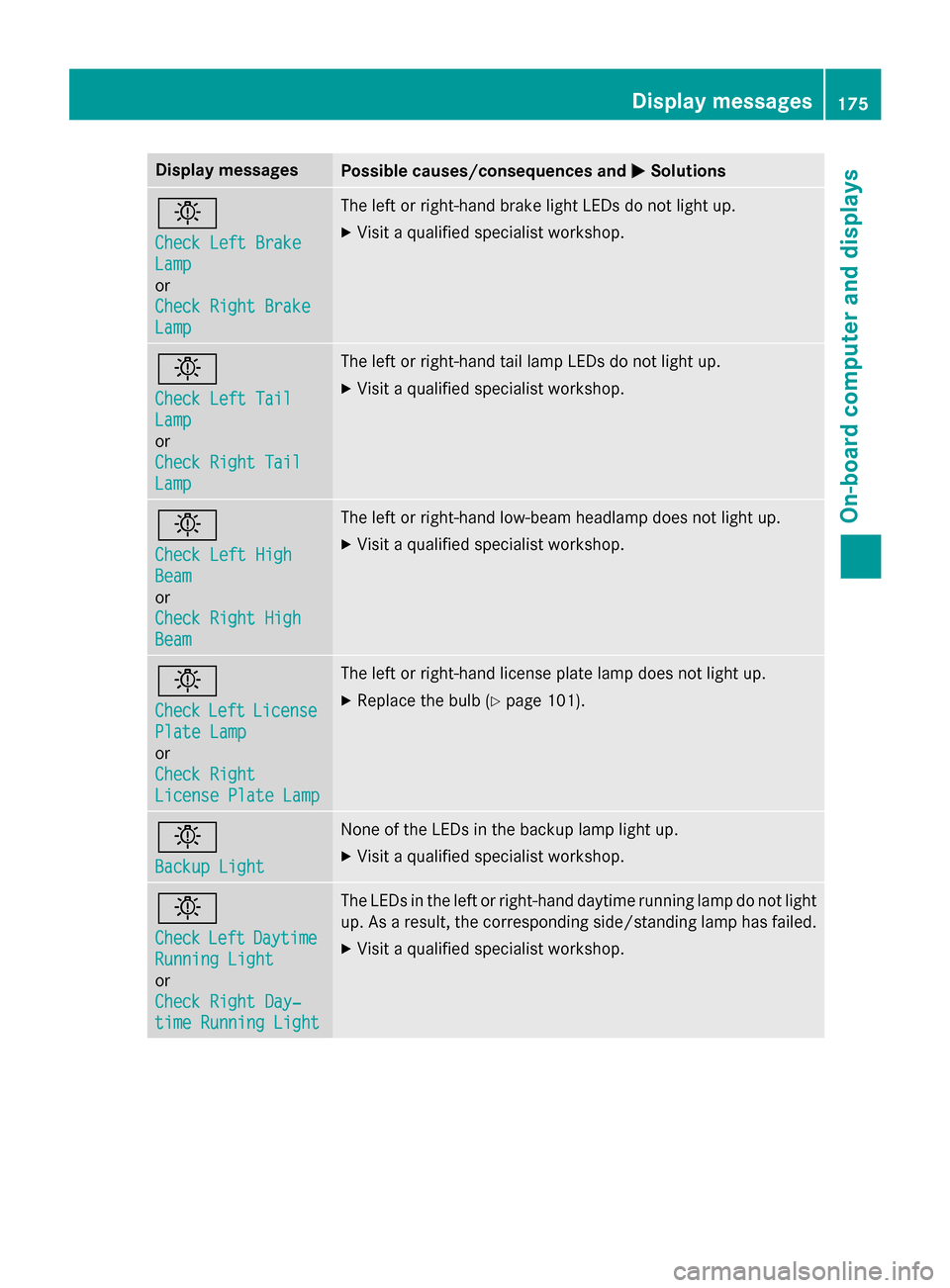
Display messages
Possible causes/consequences and
0050
0050Solutions 0049
Check Lef
tBrake
Check Lef tBrake
Lamp Lamp
or
Check Right Brake Check Right Brake
Lamp Lamp The lef
torright-hand brak eligh tLED sdon otligh tup.
X Visit aqualified specialist workshop. 0049
Check Lef
tTail
Check Lef tTail
Lamp Lamp
or
Check Right Tail Check Right Tail
Lamp Lamp The lef
torright-hand tai llamp LEDs do no tligh tup.
X Visit aqualified specialist workshop. 0049
Check Lef
tHigh
Check Lef tHigh
Beam Beam
or
Check Right High Check Right High
Beam Beam The lef
torright-hand low-beam headlamp does no tligh tup.
X Visit aqualified specialist workshop. 0049
Check Check
Left
LeftLicense
License
Plate Lamp
Plate Lamp
or
Check Right Check Right
Licens ePlate Lamp
Licens ePlate Lamp The lef
torright-hand license plat elamp does no tligh tup.
X Replac ethe bulb (Y page 101). 0049
Backup Light Backup Light Non
eoft heLEDs in th ebackup lamp ligh tup.
X Visit aqualified specialist workshop. 0049
Check Check
Left
LeftDaytime
Daytime
Runnin gLight
Runnin gLight
or
Check Right Day‐ Check Right Day‐
tim eR unnin gLight
tim eR unnin gLight The LEDs in th
eleftorr ight-hand daytime running lamp do no tlight
up. As aresult ,the correspondin gside/standin glamp has failed.
X Visit aqualified specialist workshop. Display
messages
175On-boardcomputer an ddisplays Z
Page 192 of 290
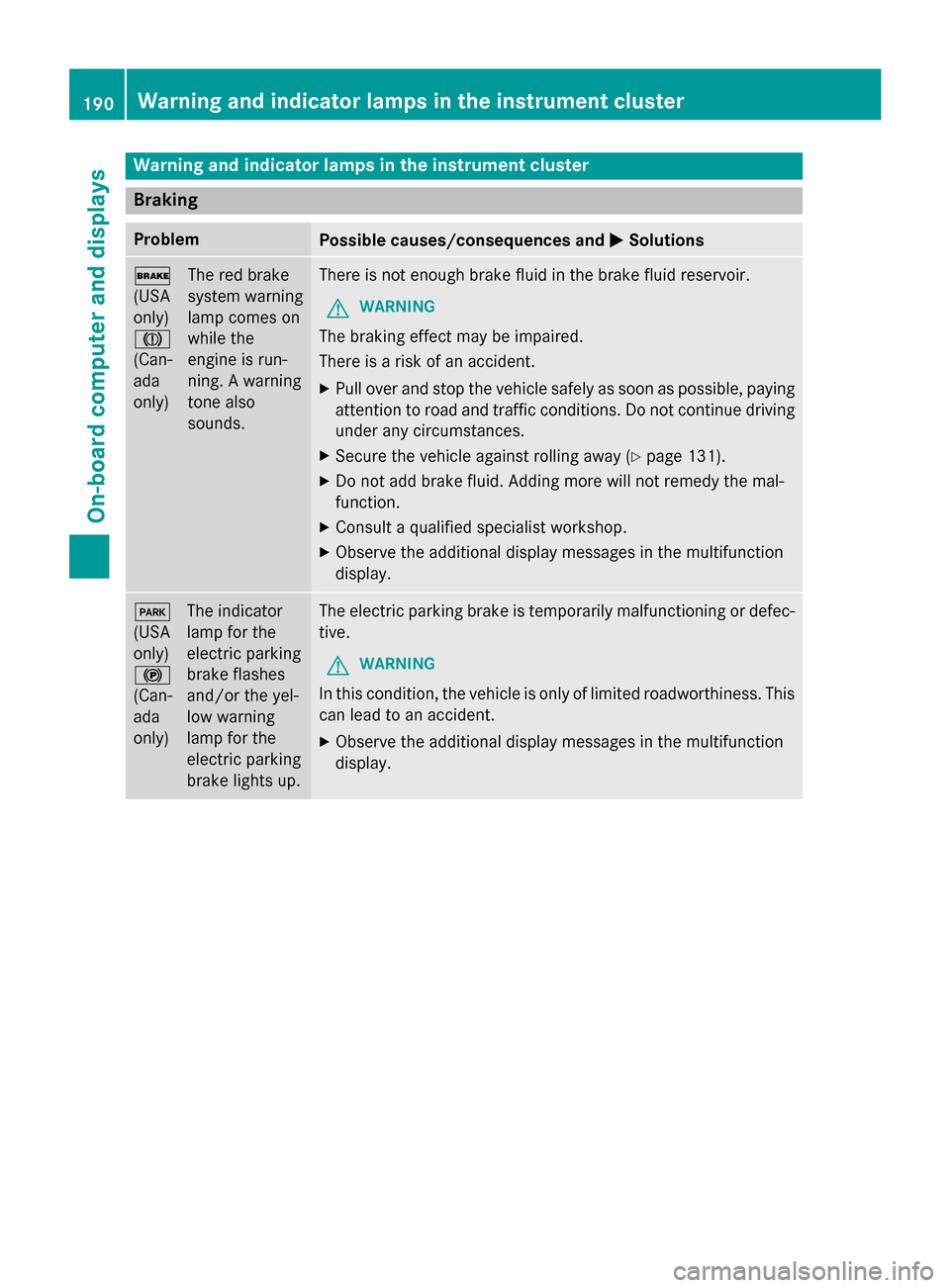
Warning and indicator lamps in the instrument cluster
Braking
Problem
Possible causes/consequencesa
nd0050
0050Solutions 0027
(USA
only)
004D
(Can-
ada
only)
The red brake
syste
mwarning
lamp comes on
while the
engine is run-
ning. Awarning
tone also
sounds. There is not enoug
hbrake fluid in the brake fluid reservoir.
G WARNING
The braking effect may be impaired.
There is arisk of an accident.
X Pul lover and stop the vehicl esafely as soon as possible ,paying
attention to road and traffic conditions. Do not continue driving
unde rany circumstances.
X Secure the vehicl eagainst rolling away (Y page131).
X Do not add brake fluid. Adding more wil lnot remed ythe mal-
function.
X Consult aqualified specialist workshop.
X Observe the additiona ldisplaym essages in the multifunction
display. 0049
(USA
only)
0024
(Can-
ada
only)
The indicator
lamp for the
electric parking
brake flashes
and/or the yel-
low warning
lamp for the
electric parking
brake lights up. The electric parking brake is temporarily malfunctioning or defec-
tive.
G WARNING
In this condition, the vehicl eisonly of limited roadworthiness. This
can lea dtoana ccident.
X Observe the additiona ldisplaym essages in the multifunction
display. 190
Warning and indicator lamps in the instrument clusterOn-board computer and displays
Page 230 of 290
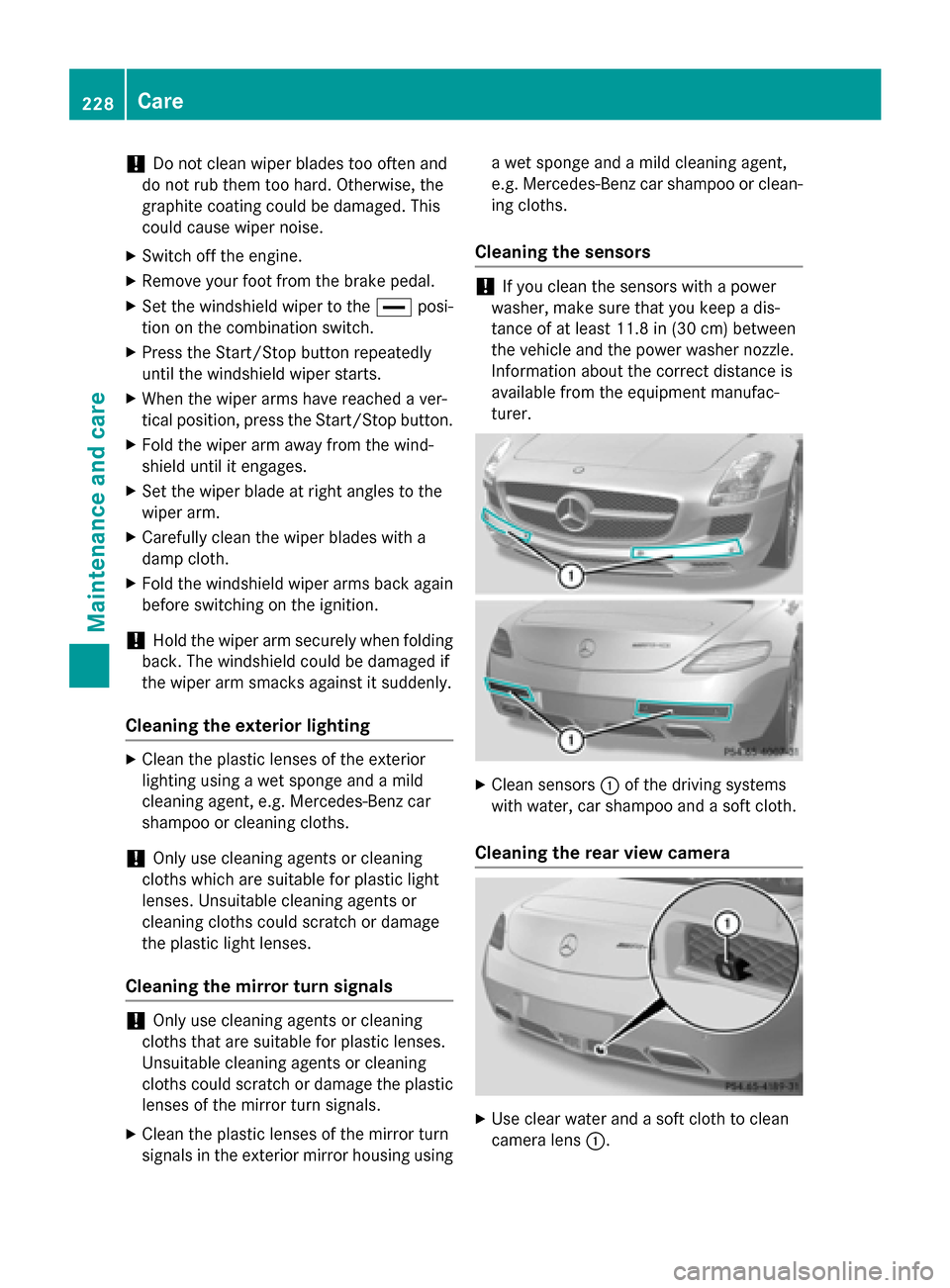
!
Do not clean wiper blades too often and
do not rub them too hard. Otherwise, the
graphite coating could be damaged. This
could cause wiper noise.
X Switch off the engine.
X Remove your foot from the brake pedal.
X Set the windshieldw iper to the00AAposi-
tion on the combination switch.
X Press the Start/Stop button repeatedly
until the windshieldw iper starts.
X When the wiper arms have reached aver-
tical position, press the Start/Stop button.
X Fold the wiper arm awayf rom the wind-
shield until it engages.
X Set the wiper bladeatr ight angles to the
wiper arm.
X Carefully clean the wiper blades with a
damp cloth.
X Fold the windshieldw iper arms back again
before switching on the ignition.
! Hold the wiper arm securely when folding
back. The windshieldc ould be damagedif
the wiper arm smacks against it suddenly.
Cleaning the exterior lighting X
Cleant he plastic lenses of the exterior
lighting using awet sponge and amild
cleaning agent, e.g. Mercedes-Benz car
shampoo or cleaning cloths.
! Only use cleaning agents or cleaning
cloths which are suitablef or plastic light
lenses. Unsuitable cleaning agents or
cleaning cloths could scratch or damage
the plastic light lenses.
Cleaning the mirror turns ignals!
Only use cleaning agents or cleaning
cloths that are suitablef or plastic lenses.
Unsuitable cleaning agents or cleaning
cloths could scratch or damage the plastic
lenses of the mirror turn signals.
X Cleant he plastic lenses of the mirror turn
signals in the exterior mirror housing using aw
et sponge and amild cleaning agent,
e.g. Mercedes-Benz car shampoo or clean-
ing cloths.
Cleaning the sensors !
If you clean the sensors with
apower
washer, make sure that you keep adis-
tance of at least 11.8 in (30 cm) between
the vehicle and the power washer nozzle.
Information aboutt he correct distance is
available from the equipment manufac-
turer. X
Cleans ensors0043of the driving systems
with water, car shampoo and asoft cloth.
Cleaning the rear view camera X
Use clear water and asoft cloth to clean
camera lens 0043.228
CareMaintenance and care
Page 245 of 290
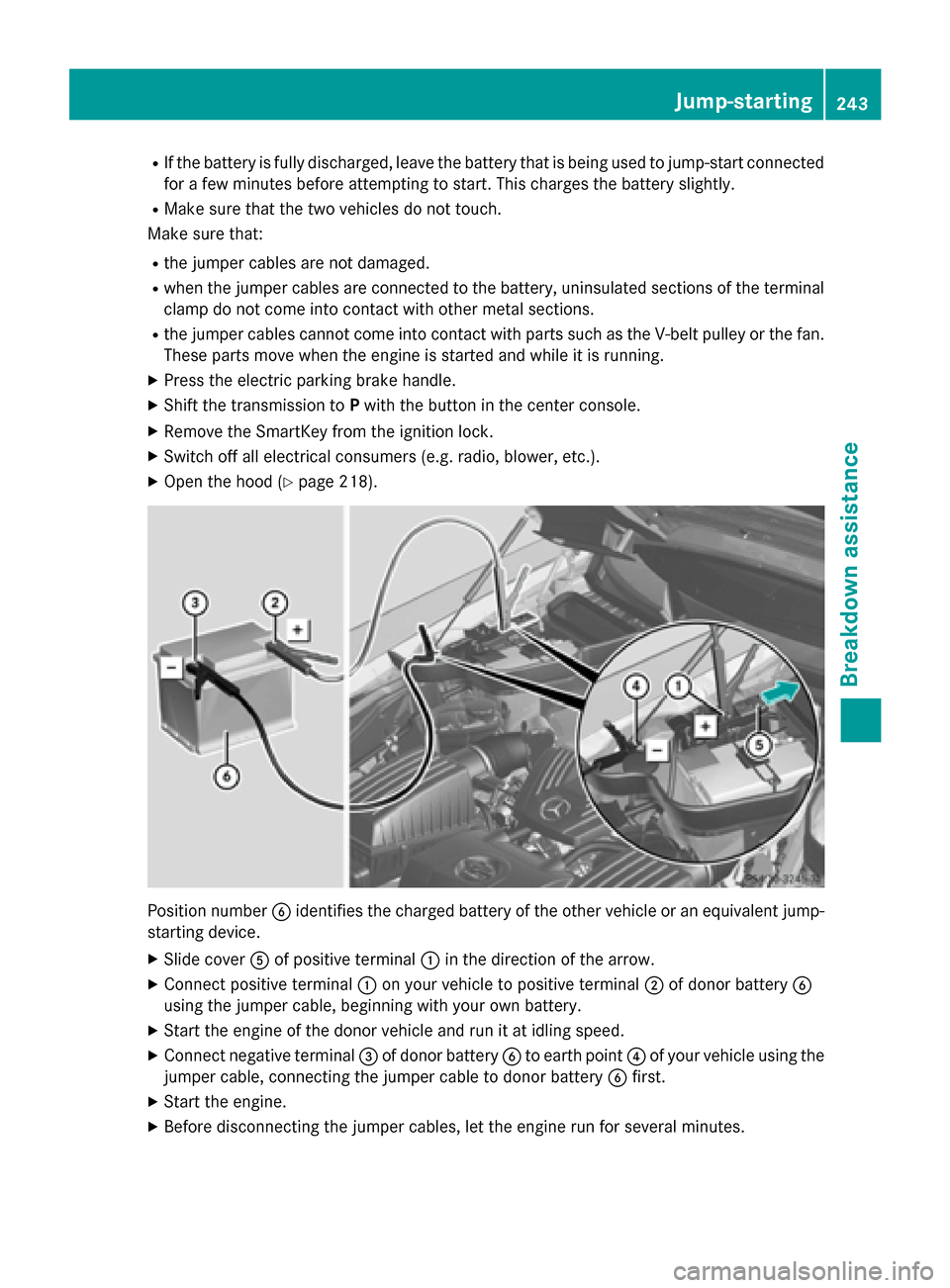
R
If the battery is fullyd ischarged, leave the battery that is being used to jump-start connected
for afew minutes before attempting to start. This charges the battery slightly.
R Make sure that the two vehicle sdonot touch.
Make sure that:
R the jumper cablesa re not damaged.
R when the jumper cablesa re connected to the battery, uninsulated sections of the terminal
clamp do not come into contact with other metal sections.
R the jumper cablesc annot come into contact with parts such as the V-belt pulley or the fan.
These parts move when the engine is started and whileitisr unning.
X Press the electric parking brake handle.
X Shift the transmission to Pwith the button in the center console.
X Remove the SmartKey from the ignition lock.
X Switch off all electrical consumers (e.g. radio, blower, etc.).
X Open the hood (Y page 218). Positio
nnumber 0084identifie sthe charged battery of the other vehicle or an equivalent jump-
starting device.
X Slide cover 0083of positive terminal 0043in the direction of the arrow.
X Connect positive terminal 0043on yourv ehicle to positive terminal 0044of donor battery 0084
using the jumper cable,b eginning with yourown battery.
X Start the engine of the donor vehicle and run it at idling speed.
X Connect negative terminal 0087of donor battery 0084to earth point 0085of yourv ehicle using the
jumper cable,c onnecting the jumper cable to donor battery 0084first.
X Start the engine.
X Before disconnecting the jumper cables, let the engine run for several minutes. Jump-starting
243Breakdown assistance Z
Page 271 of 290
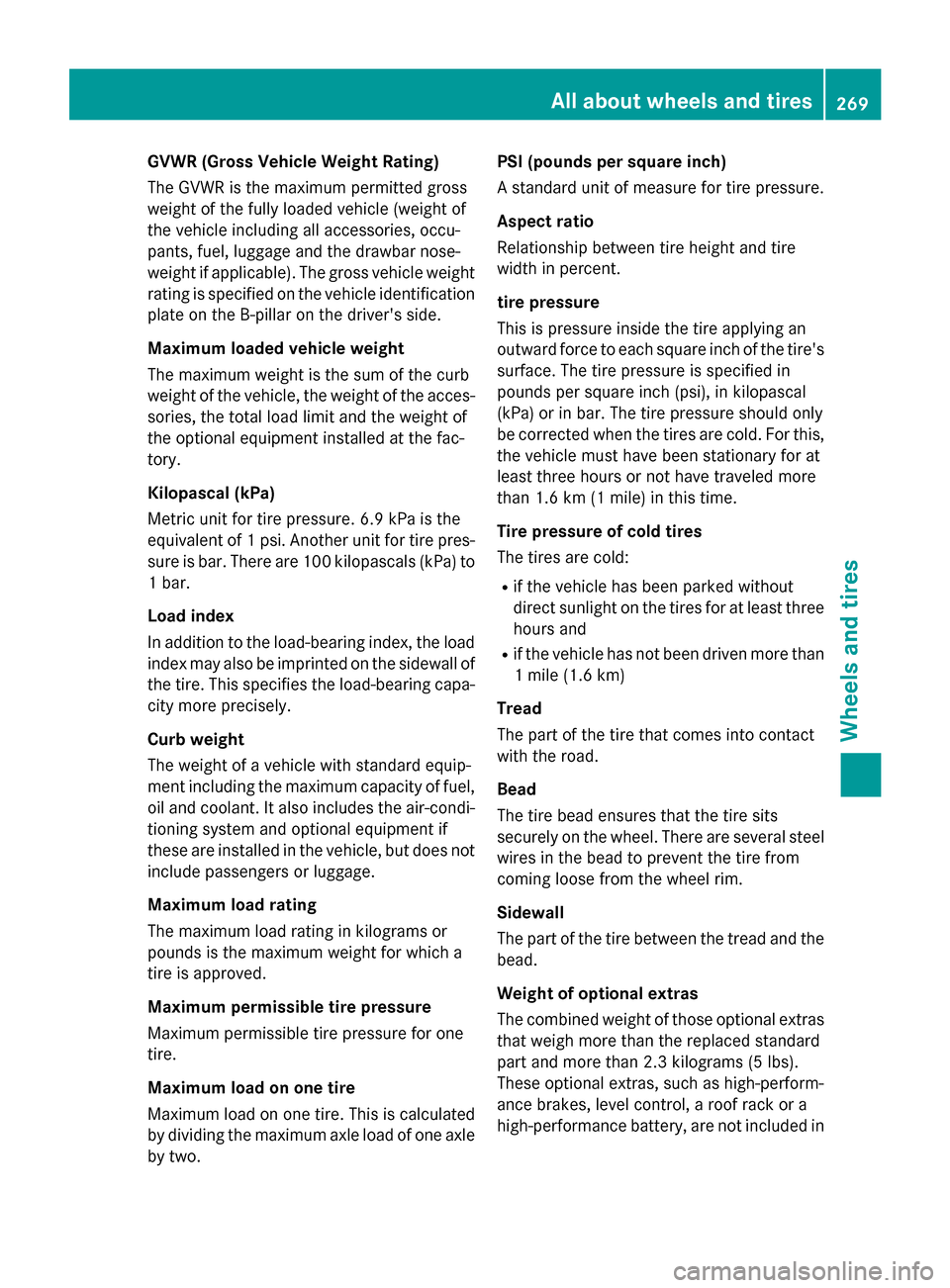
GVWR (Gross Vehicl
eWeight Rating)
The GVWR is the maximu mpermitted gross
weight of the fullyl oaded vehicle (weight of
the vehicle including all accessories, occu-
pants, fuel,l uggage and the drawbar nose-
weight if applicable).T he gross vehicle weight
rating is specified on the vehicle identification plate on the B-pilla ronthe driver's side.
Maximum loaded vehicle weight
The maximu mweight is the sum of the curb
weight of the vehicle ,the weight of the acces-
sories ,the total loadl imitand the weight of
the optional equipment installed at the fac-
tory.
Kilopascal (kPa)
Metric unit for tire pressure. 6.9 kPa is the
equivalent of 1psi.A nother unit for tire pres-
sure is bar. There are 100 kilopascals (kPa) to
1b ar.
Load index
In addition to the load-bearing index, the load index may alsobei mprinted on the sidewallof
the tire. This specifies the load-bearing capa-
city more precisely.
Curb weight
The weight of avehicle with standard equip-
ment including the maximu mcapacity of fuel,
oil and coolant. It alsoi ncludes the air-condi-
tioning system and optional equipment if
these are installed in the vehicle ,but does not
includ epassengers or luggage.
Maximum load rating
The maximu mloadr ating in kilograms or
pounds is the maximu mweight for which a
tire is approved.
Maximum permissible tire pressure
Maximu mpermissibl etire pressure for one
tire.
Maximum load on one tire
Maximu mloadono ne tire. This is calculated
by dividing the maximu maxle loadofo ne axle
by two. PSI (pounds per square inch)
As
tandard unit of measure for tire pressure.
Aspec tratio
Relationshi pbetwee ntire heigh tand tire
width in percent.
tire pressure
This is pressure inside the tire applying an
outward force to each square inch of the tire's surface. The tire pressure is specified in
pounds per square inch (psi), in kilopascal
(kPa) or in bar. The tire pressure shoul donly
be corrected when the tires are cold. For this,
the vehicle must have been stationary for at
least three hours or not have traveled more
than 1.6 km (1 mile)int his time.
Tire pressure of coldt ires
The tires are cold:
R if the vehicle has been parked without
direct sunlight on the tires for at least three
hours and
R if the vehicle has not been driven more than
1m ile (1.6 km)
Tread
The part of the tire that comes into contact
with the road.
Bead
The tire beade nsures that the tire sits
securel yonthe wheel. There are severa lsteel
wiresint he beadtop revent the tire from
coming loose from the wheelr im.
Sidewall
The part of the tire betwee nthe tread and the
bead.
Weight of optional extras
The combined weight of those optional extras
that weigh more than the replaced standard
part and more than 2.3 kilograms (5 lbs).
These optional extras, such as high-perform-
ance brakes, level control, aroof rack or a
high-performance battery, are not included in Alla
bout wheels and tires
269Wheelsand tires Z
Page 274 of 290
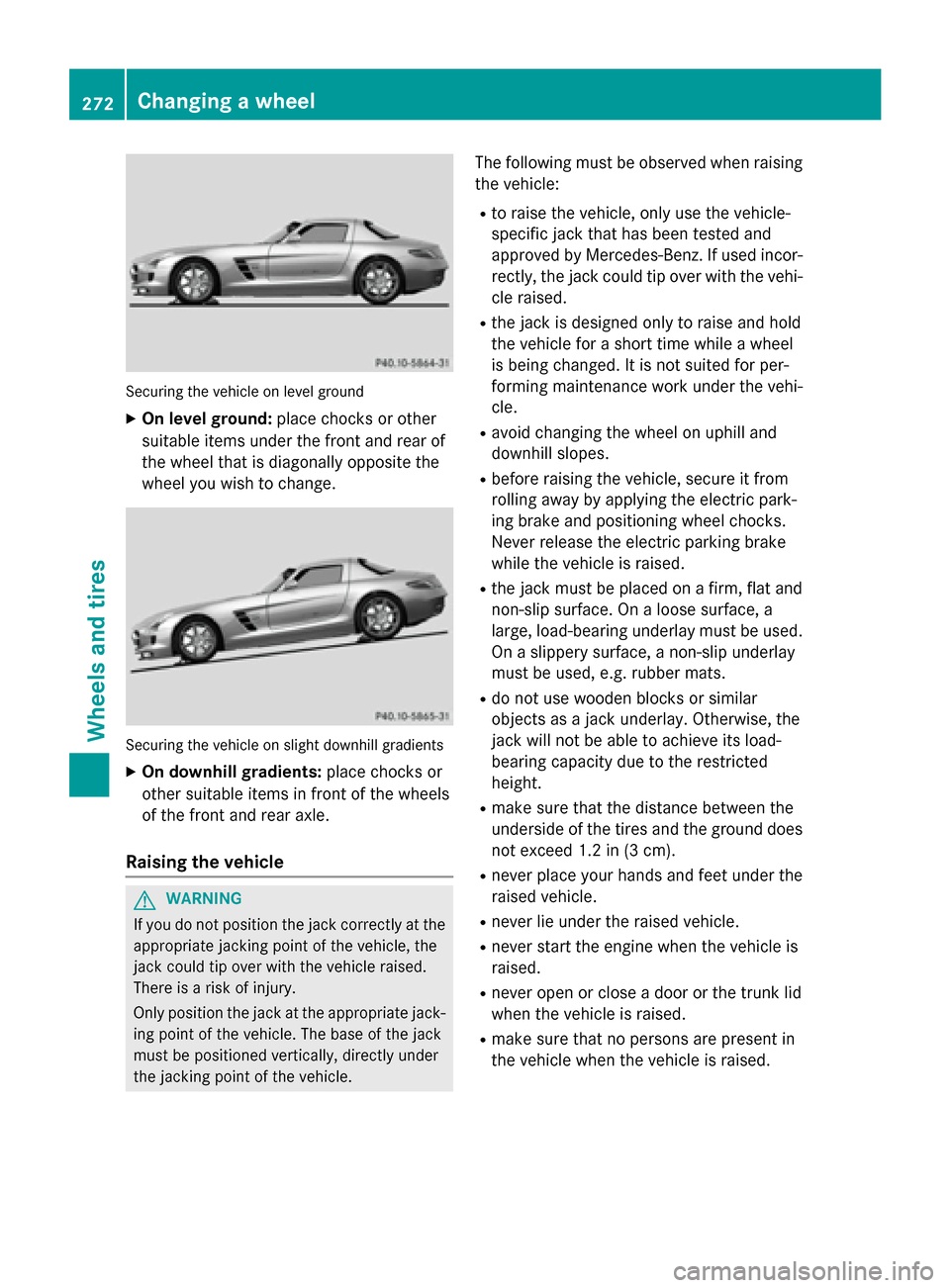
Securing the vehicle on level ground
X On level ground: place chocks or other
suitabl eitem sunder the front and rea rof
the wheel that is diagonall yopposite the
wheel yo uwishtoc hange. Securing the vehicle on slight downhil
lgradients
X On downhill gradients: place chocks or
othe rsuitabl eitem sinf ront of the wheels
of the front and rea raxle.
Raisin gthe vehicle G
WARNING
If yo udon ot position the jack correctly at the
appropriate jacking point of the vehicle ,the
jack could tip ove rwitht he vehicle raised.
There is ariskofi njury.
Only position the jack at the appropriate jack-
ing point of the vehicle .The base of the jack
mus tbep ositioned vertically ,directl yunder
the jacking point of the vehicle. The following mus
tbeo bserve dwhenr aising
the vehicle:
R to raise the vehicle ,only us ethe vehicle-
specifi cjack that ha sbeent ested and
approved by Mercedes-Benz. If used incor-
rectly, the jack could tip ove rwitht he vehi-
cle raised.
R the jack is designe donly to raise and hold
the vehicle for ashort time whil eawheel
is being changed .Itisnot suited for per-
forming maintenance work under the vehi-
cle.
R avoid changing the wheel on uphil land
downhil lslopes.
R before raising the vehicle ,secure it from
rolling away by applying the electri cpark-
ing brake and positioning wheel chocks.
Neve rrelease the electri cparking brake
whil ethe vehicle is raised.
R the jack mus tbep lace donaf irm,flata nd
non-slip surface. On aloose surface, a
large ,load-bearing underlay mus tbeu sed.
On aslippery surface, anon-slip underlay
mus tbeu sed, e.g. rubber mats.
R do not us ewoodenb locks or similar
objects as ajack underlay .Otherwise, the
jack will not be able to achieve its load-
bearing capacity du etothe restricted
height.
R make sure that the distance between the
underside of the tire sand the ground does
not excee d1.2 in (3 cm).
R never place your hands and fee tunder the
raised vehicle.
R never li eunder the raised vehicle.
R never star tthe engine when the vehicle is
raised.
R never ope norclosead oorort he trunk lid
when the vehicle is raised.
R make sure that no persons are present in
the vehicle when the vehicle is raised. 272
Changing
awheelWheels and tires